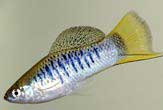Fry Why bad?

Photo: Livescience
You may think that once hatched, the fish is a strange swimmer. The reality is not so. When born, fish larvae struggle to move and survive. About 99% of the dead fish are in this larval stage.
Only when they grow up will they escape the enemy better. Adults often quickly flee thanks to the technique of jumping up and down - a technique that helps them achieve very good levels and then glides away. Many species do not have this skill at birth.
Scientists have long suspected that it is because of the light weight that young larvae cannot achieve the necessary kinetic energy during the bouncing phase. And perhaps their too small size also makes the water become like syrup, hindering their activity.
But a new study on zebrafish larvae has concluded that it is the underdeveloped lateral finnage and the ineffective swim bladder that holds them back. The fish simply cannot keep the body stable in a horizontal way.
The finding may also apply to other fish species, the team said.
" Kinetic energy can explain the poor swimming condition of some fish larvae, but not all, and the difference in ability to break down cannot be explained by the difference in their body length. "Research leader Ulrike Muller from Wageningen University in the Netherlands said. " Many fish larvae hatched with pectoral fins have not fully developed, and they are all born without swimming bubbles, so the same problem in seahorses can happen to them ."
T. An
 Surprised: Fish that live in the dark ocean still see colors
Surprised: Fish that live in the dark ocean still see colors Japan suddenly caught the creature that caused the earthquake in the legend
Japan suddenly caught the creature that caused the earthquake in the legend A series of gray whale carcasses washed ashore on California's coast
A series of gray whale carcasses washed ashore on California's coast Compare the size of shark species in the world
Compare the size of shark species in the world